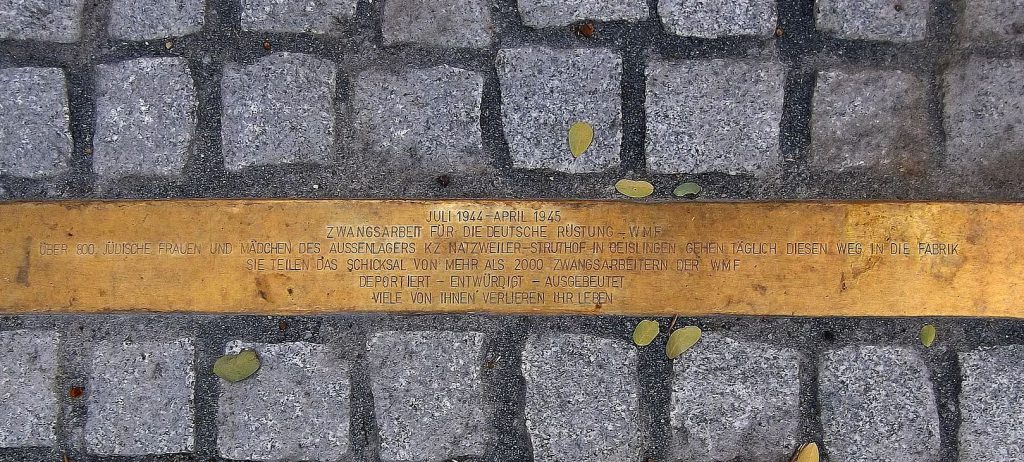A short outline of the history of the Branch Camp Geislingen of Concentration Camp Natzweiler

July 1944 – April 1945: Forced labor for the German armaments industry – WMF. Over 800 Jewish women and girls from the Natzweiler – Struthof subcamp in Geislingen made their way to the factory every day. They share the fate of more than 2000 forced laborers at WMF. Deported – incapacitated – exploited. Many of them lose their lives.
Inscription on the Stumbling sill
The installation of the Branch Camp Geislingen of Concentration Camp Natzweiler is due to the demand for forced labour for the armament production of WMF (Wuerttemberg Metal Works) with the WVHA (Wirtschaftsverwaltungshauptamt/ Main office for economic administration) in spring 1944.
The camp was separated from the existing forced labour camp in Heidenheimer Strasse and isolated by barbed wire and barring screens from the outside world. The first group of prisoners of about 700 Jewish women from Auschwitz arrived on July 28 1944 in the camp, even before the SS guards that been sent to Ravensbrueck for training were ready for action. Till then only male guard staff from main camp Natzweiler controlled the Geislingen branch camp. The employment of the female prisoners started on August 15 1944 and was controlled by SS guards, former unskilled workers of WMF. In the camp a Jewish “Selbstverwaltung/ self-governing body) was set up controlled by the SS, until at the end of October six German political prisoners from Ravensbrueck were set up as Funktionshäftlinger (function prisoners). According to Jewish women witnesses the camp conditions deteriorated massively.
Shortly before the replacement of 1st Schutzhaftlagerführer (protective custody camp leader) Ahrens 12 sick or pregnant Jewish women were “sent back” for extermination to Auschwitz. Because of irregularities in his conduct as a leader 2nd Schutzhaftlagerführer Schopp was replaced by his colleague Roman at the beginning of 1945. He had been in charge of Echterdingen camp till then. The Schutzhaftlagerführers mentioned above were subordinated to the control of the Natzweiler commanders Hartjenstein and Schwarz, both of which had been deployed in Auschwitz-Birkenau and Monowitz.
The second group of prisoners consisting of 120 Polish Jewish women who had been deported to Auschwitz-Birkenau and Bergen-Belsen after the desolving of the Lodz (Litzmannstadt) ghetto arrived for employment at WMF Geislingen at the end of November 1944. The camp conditions aggravated at the beginning of February 1945 by a capo group of ten which were assigned to be “Asoziale (antisocial elements)” by the Nazis. They were sent via Ravensbrück to Geislingen after the desolving of camp Auschwitz.
The employment of the prisoners with WMF ended in the middle of March 1945 because of a lack of raw materials and because of the collapse of the transportation system. From this point of time the SS hired out prisoners to private people who were supposed to secure the provisional survival of the hungry prisoners by paying them with natural produce.
With the appearance of about 200 more female prisoners from the desolved camps Geisenheim on the Rhine and Calw at the beginning of April the plight in the camp was aggravated again. On April 11th 1945 camp Geislingen was desolved by transporting all prisoners to Allach. The prisoners were imprisoned for a short time in Allach before they were loaded into freight trains heading for Tyrolia. They were liberated by the Americans on April 30th 1945 on Lake Starnberg.
On September 2015 Gunter Demnig layed the Stolperschwelle (Stumbling sill) in front of the main WMF building in Eberhardstrasse 25.
The history of Geislingen Branch Concentration Camp and the fates of its inmates are desribed in detail in Sybille Eberhardt’s book “Als das ‚Boot‘ zur Galeere wurde…” (ISBN 978-3-95544-100-5).
(25.11.2019 se /pr)


Leave a Reply